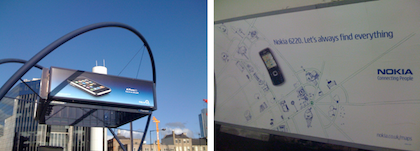
Tom Himpe heeft een paar jaar geleden een presentatie op SlideShare gezet. Eén sheet is me altijd bijgebleven. Het is nummer 17, de afbeelding hierboven is er een stukje van.
Het komt er in het kort op neer dat merken die echt toegevoegde waarde bieden (‘nut’), dat slechts hoeven te vertellen. Hun communicatie is helder en eenvoudig: dit hebben we en dit kun je ermee.
Merken die een propositie hebben die minder onderscheidend is, gebruiken een rookgordijn. Ze stoppen een hoop hippe afleiding in hun communicatie om iets gemiddeld toch bijzonder te maken. Het komt wat krampachtig over en is spelen via de band.
Als je het zo ziet, is het vrij logisch. Het gaat om Apple (duidelijkheid) vs. Nokia (een rookgordijn).
Maar, vertaal deze benadering eens naar sociale media. Veel merken voeren populaire campagnes. Maar vallen deze in categorie 1? Of in de 2e? Met andere woorden: onderstrepen ze hun toegevoegde waarde? Of creëren ze een rookgordijn, dat werkt op korte termijn, maar het op lange termijn moeilijker maakt een structurele relatie aan te gaan met mensen: want, wat heb je er eigenlijk aan, wat is hun nut?
Want natuurlijk helpt het, als je een merk leuker vindt, bijvoorbeeld naar aanleiding van een ‘viral’. Maar dat is het extraatje, de bijzaak als je in een winkel staat en moet kiezen tussen twee producten die even goed zijn. Dan kies je voor de leuke. Maar als het ene merk iets beters doet dan de andere – nuttiger is – kies je toch voor de betere. Het merk dat je al vaker verder heeft geholpen, bijvoorbeeld online.
En daar kan sociale media nu zo goed voor gebruikt worden. Mensen kun je daar niet alleen amuseren, je kunt hen ook daadwerkelijk met dingen helpen. Je legt er immers 1 op 1-relaties. Dus je kunt mensen helpen om makkelijker met elkaar te sporten, communiceren, betalen, een feestje te organiseren, vakantieplannen te maken etc. etc.
Ofwel, prima mogelijkheden voor merken die zich focussen op sport, communicatie, betalen, lol en reizen om te laten zien dat ze niet alleen op aarde zijn om leuk te doen, maar dat ze ook behoorlijk nuttig kunnen zijn.
Dus: wat is de Sociale Service Strategie van jouw merk?



